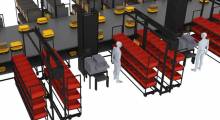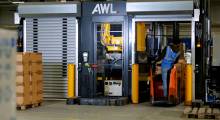At WasteExpo 2021 in Las Vegas this week, AMP Robotics Corp. announced that it had passed company milestones executing against its plan to sustainably improve and scale the recovery of recyclables. The Louisville, Colo.-based company has been continuing its development of robotics and artificial intelligence for the global recycling industry and its market expansion.
“We entered 2021 with momentum driven by strong demand for our recycling AI and automation solutions, and it continued through the first half of the year, as we continued to deploy systems at scale and doubled year-over-year revenue,” stated Matanya Horowitz, founder and CEO of AMP Robotics. “Our investment in operational scale is paying off as we see even stronger adoption of our technology, with customers re-ordering systems to install in other facilities that they own.”
“We continue to innovate with the pilot of our automated secondary sortation facility, as well as the launch of AMP Clarity, our new waste- characterization software,” he added at the event. “AI is powering real-world solutions for the recycling system that may have seemed out of reach not long ago.”
Recycling data to encourage modernization
A lack of data transparency, reliability, and consistency on the performance of material recovery has been a longstanding obstacle to recycling modernization, said AMP Robotics.
The AMP Neuron AI system continuously trains itself by recognizing different colors, textures, shapes, sizes, patterns, and even brand labels to identify materials and their recyclability.
Neuron then guides robots to pick and place the material to be recycled. Designed to run 24/7, all of this happens at superhuman speed with extremely high accuracy, said the company. It claimed that AMP Neuron's artificial neural network “has created the largest known real-world dataset of recyclable materials for machine learning.”
With the power of this data, AMP said it has achieved two milestones:
- The company can now classify more than 100 different categories and characteristics of recyclables across single-stream recycling, e-scrap, and construction and demolition debris.
- AMP has extended its object-recognition run rate to more than 10 billion items annually. This combination of scalable accuracy and classification creates a step-level solution for data collection and measurement that materials recovery facilities can use to optimize their operations. Reclaimers, mills, and manufacturers can use to validate that incoming feedstock meets specifications and standards for chemically compliant bales. In addition, brand owners and government stakeholders can use to measure the quality, flow, and recovery of recyclable materials.
The modularity of the standalone AMP Vision system provides economically viable, pervasive sensor technology that can be deployed across the recycling system, so this data can be collected throughout different facilities, waste sheds, and municipalities, said the company.
AMP Clarity can provide data and material characterization on what recyclables are captured and missed, helping recycling businesses and producers maximize recovery. It recently deployed six robotic sorting systems with Clyde, Ohio-based bottle recycler Evergreen.
New gripper technology improves performance
AMP Robotics has also continued to add material-specific feature sets and performance enhancements to support more precise automated sortation and rapid recovery of high-value commodities. With more than one dozen patents or patents pending, the company said it has focused on continuous improvements to the performance and reliability of its flagship robotic sorting system, AMP Cortex.
AMP Cortex automates the identification and sorting of recyclables from mixed material streams. In recent months, AMP has been testing a new gripping technology that pushes the existing boundaries of its proprietary robotic path planning to accelerate pick speeds beyond what had previously been considered possible.
In June, AMP marked a breakthrough, recording speeds of up to 140 picks per minute on a single robot and a sustained rate of 120 picks per minute on many common picking layouts. This can translate to an increase of more than 50% in recovery for unevenly distributed material streams, it said.
This latest innovation is focused initially on optimizing the recovery of recyclable fiber like mixed paper, OCC (corrugated cardboard), and SOP (sorted office paper). AMP will be beta-testing these new performance features in the field with select customers over the next three to six months and expects to commercialize the offering more broadly as a feature upgrade by the end of 2021.
AMP adds personnel to support expansion
Over the past year, AMP Robotics has rapidly scaled its business to meet demand. In less than 12 months, the company has doubled its staff—hiring in finance, operations, engineering, product management, sales, marketing, service, and talent management. AMR raised $55 million in Series B funding in January.
With deployments across North America, Asia, and Europe, AMP’s technology recovers recyclables from municipal collection, precious commodities from electronic scrap, and high-value materials from construction and demolition debris.
Following the installation of the company’s first robotic system in Europe in late 2020, AMP said its pipeline continues to grow. U.K.-based Gary Ashburner has joined AMP as its general manager for Europe, the Middle East, and Africa. He plans to build out the company’s European infrastructure, leading customer and partner acquisition, pre- and post-sales consulting, system design, supply, installation, training and service.
After AMP’s successful launch of its automated secondary sortation model, it added Bart Weihl as vice president of facility operations to lead the team managing the buildout of its future facilities. Prior to AMP, Weihl was vice president at Barnes Aerospace and held advanced manufacturing and supply chain roles at Owens Corning, GE, and Boeing.
Article topics
Email Sign Up
















